The Migration North
Migrating gray whales usually swim singly or in small groups. This picture, taken from a helicopter, shows a small group of adult gray whales that has just surfaced and taken a breath (notice the lingering "blow" in the air). The group is on their way north, past California. (Image, with permission, from California Gray Whale Coalition) |
| Travelling north along the coast of western North America, the gray whale is often seen during the spring months on its way back to its feeding grounds in the Bering Sea. They may travel about half as fast on their return to the Arctic (55 miles per day) and some may linger along the coast of southeast Alaska (or the northwestern United States) to do the majority of their summer feeding. The females who are newly pregnant leave the lagoons in Baja first (usually in February), followed by the males and immatures. The females who gave birth in January or February are the last to leave. They stay in the lagoons with their babies until March or April, nursing and exercising the babies in preparation for the spring migration back to their feeding grounds. The babies are weaned at about 7 months when they are about 27 feet in length and are back in the Bering Sea (where their food is located). It takes about 5 - 10 years for gray whales to become sexually mature but most members make this 11, 000 to 12,000 mile (round trip) migration each year. The gray whale reaches full size after about 40 years with males about 42 feet long and females about 49 feet long. |
 |
This baby gray whale lacks the characteristic patches of ectoparasites and scars from these patches. Its smooth gray skin even shows small indentations on the rostrum (upper jaw) where hair follicles are located (whiskers). (Image, with permission, from David Blue) |
| Migration data about individual gray whales can be taken by comparing photographs. The placement of the ectoparasite patches on a whale, as well as the scars left by these patches are unique to each individual (much like our fingerprints are unique to each person). Photographs of gray whales often look blurry because of their very mottled color patterns but researchers can still use photographs taken by tourists to increase their database. |
'Stumpy,' photo taken in June 1983 next to Santa Cruz Island - near Santa Barbara, California. (SA image) |
| Occasionally a whale will be so unique that it is easily known. For example, a gray whale without flukes (tail) was sighted for several years along California during its migration. It was presumed that a predator (great white shark or killer whale) either bit off the flukes or that the flukes had been caught in a net and either torn off by the whale's need to surface and breathe or rotted off by restriction of blood vessels. This whale (called 'stumpy' by many) was seen for several years in San Ignacio lagoon (at least up to 1997, personal communication with Carole Adams, Friends of the Elephant Seal docent). Whale researchers from Mexico, California, and Canada compared their photographs to confirm that this was the same whale. This whale was able to make the long migration even without its powerful tail that provides its major means of propulsion, quite a feat. |
'Stumpy,' photo taken February 1997 in San Ignacio Lagoon. (Image, with permission, from Carole Adams) |
'Stumpy,' photo taken February 1997 in San Ignacio Lagoon. (Image, with permission, from Carole Adams) |
| 'Stumpy' visited San Ignacio Lagoon in February 1997, when the two photos (above) were taken. Carole Adams kindly gave me permission to post these two images which taken by members of her group. The naturalists with Carole's group indicated that 'stumpy' had given birth to a calf one year while in San Ignacio and had been seen several years prior to Carole's visit in 1997. Carole's group (and mine in March 2000) are some of the lucky folks to have had the magical experience of seeing the gray whales in San Ignacio Lagoon. The naturalists with my group, in 2000, had not seen stumpy that year in San Ignacio Lagoon but they fondly remembered her and we shared our 1983 photograph with them. |
This adult whale shows the characteristic patches of ectoparasites, scars and splotchy pigmentation that is common in the gray whale. Note its two open blow holes. GA image) |
| Once found in both the North Pacific and North Atlantic Oceans, fossil remains are all that is left of the Atlantic population and they are now extinct. The reasons for their extinction, in the Atlantic Ocean, are obscure but it appears that they disappeared in the late 1600s. Today most gray whales are thought to have a life expectancy of 60 years and some have lived at least 75 years. The population of the California gray whale appears to be in good health. But, this is quite a different situation than in the recent past. |
|

